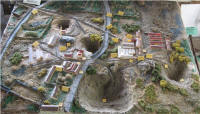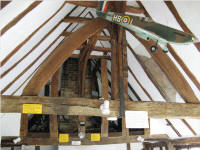Woolpit Village Museum

Woolpit Museum is located on the upper floor of this early 16th century
cottage. The entrance is via the white, bricked building to the left in
this picture
In the mid 1980s Woolpit History Group started field-walking
throughout the parish. After several years three Roman sites and eight
Medieval sites had been found and confirmed.
In 1983 the Parish Council asked if it would be feasible to
display what had been found and so the Woolpit and District Museum
was begun. The History Group took over a store-room on the
upper floor of the Woolpit Village Memorial Institute and began
to set up the smallest Museum in the county.
Because the room is so small some displays are changed each year, and over the
last thirty or so years there have been nearly seventy different exhibitions
explaining the history of Woolpit from Anglo-Saxon times to the present day.
There are two permanent displays. The first shows the famous Woolpit
Brickmaking Works presented as a 3D model of the site as it was
in its later days, with a collection of bricks, tiles, photos and various tools
used in the trade. A booklet The History of Woolpit
Brickworks is available in the small shop. The second display is a
reconstruction of a Victorian Kitchen with artefacts, which
might have been used in everyday life up to the 1920s.
New for 2019
- New for this year is a display entitled �After the War�. This includes information about local men who fought in WW1 and survived, and how they were integrated back into the community after being discharged. It also looks at the impact of Spanish flu, celebrations held in the village to mark the Treaty of Versailles and how Woolpit remembered the men who lost their lives in the conflict.
- Our other new display is about St Mary�s church. We have a model to help illustrate notable features of the building and a timeline to mark important events in its long history. Both displays are complemented by photographs of the village dating from circa 1900 to about 1930.
- Our two popular permanent displays, the brickworks and the Victorian kitchen, have been cleaned and refreshed and we are keeping the Green Children display up for another year as so many visitors are interested in this legend.
- We will also have for sale a booklet about the 25 Woolpit men who lost their lives in WW1 and are remembered on the war memorial. This is a compilation of the �biographies� of the men that were displayed in the museum during the centenary years and then shown altogether in the church as part of the armistice commemorations.
 |
 |
| Model of brickworks site |
The museum roof |
The Museum is open every Saturday, Sunday and Bank Holiday Monday from 2:00pm �
4:30pm from the beginning of April until the last week-end of September. We also open on
Wednesday afternoons in August 1pm to 3.30pm.
There is a car park opposite the Church and on street parking.
Refreshments can be bought in the village. There is also a picnic site.
By prior arrangement the museum can be opened at other times, and coach parties
are welcome. Talks and tours can be arranged by appointment.
The museum has some information relating to the village and families, which can
be made available for visitors to consult.
Contact [email protected] We look
forward to seeing you sometime.
|




